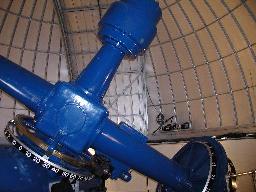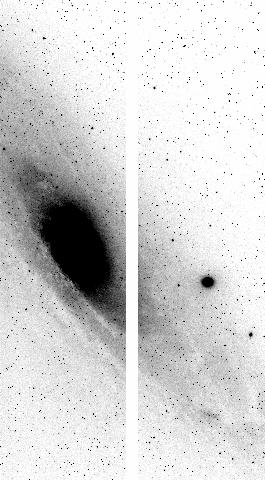Note: Several sections of this manual are adapted from the KPNO Burrell Schmidt manual (Massey, Schoening, & Armandroff 1996).
This manual describes the operation of the Burrell Schmidt telescope. The Burrell Schmidt telescope is used primarily with a large-format CCD for wide-field imaging. If you find errors, or feel that there is other information that you would find useful, please send email to harding@dropbear.astr.cwru.edu or heather@vegemite.astr.cwru.edu.
This HTML manual is available online at http://burro.astr.cwru.edu/Schmidt/Schmidt_Manual/, and locally on the Burrell Schmidt computers (emu and koala) as file:/homee/root/Schmidt_Manual/index.html


An image of M31, taken from the Schmidt. The image size is 0.75 degrees North-South by 1.5 degrees East-West. This image was taken in dual amplifier mode, so the stripe down the center is the overscan.
The Burrell Schmidt telescope is a 0.61m (corrector)/0.9m (primary) f/3.5 telescope with a plate-scale of 96.6"/mm and a direct CCD camera off of the Newtonian focus. Objective prisms are available for low-dispersion spectroscopy, but will involve serious preparation for use. The corrector of the Burrell Schmidt is figured to provide seeing-limited images over the wavelength range 3500-11000 A.
The Burrell Schmidt is operated manually rather than by computer aid, with setting circles rather than encoders. (An auto-guider does allow the astronomer to spend his/her time on more useful activities than hand-guiding!)
The Burrell Schmidt is owned by the Case Western Reserve University, and publications that result should carry the following footnote:
Observations made with the Burrell Schmidt of the Warner and Swasey Observatory, Case Western Reserve University.
If you have any problems that cannot be resolved by reading this manual, call Peter Mack at 579 0698 (only before 11.30pm). Peter will try to solve the problem with you over the phone, and if that is not possible he will in some cases come up the next day to sort it out further, and in some cases he may come up that night.
Last Updated: 10/6/02